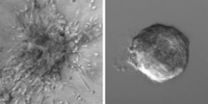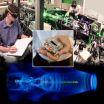(Press-News.org) Parents with a higher number of stressors in their lives are more likely to have obese children, according to a new study by pediatric researchers. Furthermore, when parents perceive themselves to be stressed, their children eat fast food more often, compared to children whose parents feel less stressed.
"Stress in parents may be an important risk factor for child obesity and related behaviors," said Elizabeth Prout-Parks, M.D., a physician nutrition specialist at The Children's Hospital of Philadelphia, who led a study published online today in the November issue of Pediatrics. "The severity and number of stressors are important."
Among the parental stressors associated with childhood obesity are poor physical and mental health, financial strain, and leading a single-parent household, said Prout-Parks. Although previous researchers had found a connection between parental stress and child obesity, the current study covered a more diverse population, both ethnically and socioeconomically, than did previous studies.
The study team suggested that interventions aimed at reducing parental stress and teaching coping skills may assist public health campaigns in addressing childhood obesity.
The researchers analyzed self-reported data from 2,119 parents and caregivers who participated in telephone surveys in the 2006 Southeastern Pennsylvania Household Health Survey/Community Health Database, conducted in Philadelphia and neighboring suburbs. The households contained children aged 3 to 17, among whom 25 percent were obese. Among the variables included were parental stressors, parent-perceived stress, age, race, health quality and gender of children, adult levels of education, BMI, gender, sleep quality, and outcomes such as child obesity, fast-food consumption, fruit and vegetable consumption, and physical activity.
Of the measured stressors, single-parent households had the strongest relationship with child obesity, while financial stress had the strongest relationship for a child not being physically active. Unexpectedly, neither parent stressors nor parent-perceived stress was associated with decreased fruit and vegetable consumption by their children.
However, this study was the first to find an association between parent-perceived stress and more frequent fast-food consumption by children. Fast food, often containing high quantities of fat and sugar, is an important risk factor for obesity and child health. The researchers speculated that parents experiencing stress may buy more fast food for the family, to save time or reduce the demands of meal preparation. The authors also suggest that actual and perceived parental stress may result in less supervision of children, who may then make unhealthy food and activity choices.
"Although multiple stressors can elicit a 'stressor pile-up,' causing adverse physical health in children, parent's perception of their general stress level may be more important than the actual stressors," the authors write.
Future research on child obesity should further examine other family behaviors and community factors not available in the current study, conclude the authors. In addition, "Clinical care, research and other programs might reduce levels of childhood obesity by developing supportive measures to reduce stressors on parents," said Prout-Parks. "Teaching alternative coping strategies to parents might also help them to reduce their perceived stress."
###"Influence of Stress in Parents on Child Obesity and Related Behaviors," Pediatrics, published online Oct. 22, 2012, and in print, Nov. 2012. www.pediatrics.org/cgi/doi/10.1542/peds.20120895
Dr. Prout-Parks' co-authors were Shiriki Kumanyika, Ph.D., MPH, from the Center for Clinical Epidemiology and Biostatistics at the University of Pennsylvania School of Medicine; Renee H. Moore, Ph.D., Center for Weight and Eating Disorders and Center for Clinical Epidemiology and Biostatistics at Perelman School of Medicine at the University of Pennsylvania School of Medicine; Nicolas Stettler, M.D., MSCE, of Exponent, Inc.; Brian H. Wrotniak, Ph.D., Center for Weight and Eating Disorders and the University of Buffalo; and Anne Kazak, Ph.D., ABPP, of The Children's Hospital of Philadelphia.
The Children's Hospital of Philadelphia was founded in 1855 as the nation's first pediatric hospital. Through its long-standing commitment to providing exceptional patient care, training new generations of pediatric healthcare professionals and pioneering major research initiatives, Children's Hospital has fostered many discoveries that have benefited children worldwide. Its pediatric research program is among the largest in the country, ranking third in National Institutes of Health funding. In addition, its unique family-centered care and public service programs have brought the 516-bed hospital recognition as a leading advocate for children and adolescents. For more information, visit http://www.chop.edu.
Greater parental stress linked to children's obesity, fast food use and reduced physical activity
2012-10-22
ELSE PRESS RELEASES FROM THIS DATE:
Friendship 2.0: Teens' technology use promotes sense of belonging, identity
2012-10-22
With adolescents seemingly glued to cell phones and social networking websites, experts are investigating whether the near-constant digital activity changes youths' development.
A new study from the University of Washington shows that digital media helps teens reach developmental milestones, such as fostering a sense of belonging and sharing personal problems. But the study also raised questions about whether digital connectedness might hinder the development of an autonomous sense of self.
Katie Davis, an assistant professor in the Information School and an expert ...
Breast cancer cells enticed to spread by 'tumorous environment' as well as genetic changes
2012-10-22
A new study from Johns Hopkins researchers suggests that the lethal spread of breast cancer is as dependent on a tumor's protein-rich environment as on genetic changes inside tumor cells.
In a report in the Sept. 25 issue of the Proceedings of the National Academy of Sciences, the scientists conclude that a molecular signal in the protein meshwork surrounding the breast cancer cells may provide the critical trigger to initiate the life-threatening process of metastasis to distant sites in the body.
Moreover, their experiments suggest that the environment surrounding ...
Clue to cause of Alzheimer's dementia found in brain samples
2012-10-22
Researchers at Washington University School of Medicine in St. Louis have found a key difference in the brains of people with Alzheimer's disease and those who are cognitively normal but still have brain plaques that characterize this type of dementia.
"There is a very interesting group of people whose thinking and memory are normal, even late in life, yet their brains are full of amyloid beta plaques that appear to be identical to what's seen in Alzheimer's disease," says David L. Brody, MD, PhD, associate professor of neurology. "How this can occur is a tantalizing ...
State-of-the-art beams from table-top accelerators
2012-10-22
Focusing in on beam focus
The rapidly evolving technology of laser plasma accelerators (LPAs) – called "table-top accelerators" because their length can be measured in centimeters instead of kilometers – promises a new breed of machines, far less expensive and with far less impact on the land and the environment than today's conventional accelerators.
Future LPAs offer not only compact high-energy colliders for fundamental physics but diminutive light sources as well. These will probe chemical reactions, from artificial photosynthesis to "green catalysis"; unique biological ...
Scattered X-rays reveal diseased tissue
2012-10-22
This press release is available in German.
Chronic obstructive pulmonary disease (COPD) is considered the fourth most common cause of death in the United States. Usually the precursor to this life-threatening lung disease is a chronic bronchitis. Partially destroyed alveoli and an over-inflation of the lungs, known as emphysema, are serious side effects. However, the subtle differences in the tissue are barely discernable in standard X-ray images.
In addition to the conventional X-ray images, the Munich scientists analyzed the radiation scattered by the tissue. ...
Fewer patient deaths after surgery in hospitals known for good nursing care
2012-10-22
Patients treated in magnet hospitals (specially designated for their nursing excellence) had 14 percent lower odds of death than those in non-magnet hospitals in a four-state study of 564 hospitals led by the University of Pennsylvania School of Nursing. The magnet designation, determined by the American Nurses Credentialing Center, recognizes high-quality patient care, high levels of nurse education, and nursing innovation.
"Even controlling for differences in nursing, hospital, and patient characteristics, surgical patients fared better in magnet hospitals," said lead ...
Energy-sensing switch discovery could have broad implications for Biology & Medicine
2012-10-22
LA JOLLA, CA – October 21, 2012 – Biochemists at The Scripps Research Institute (TSRI) have discovered a genetic sequence that can alter its host gene's activity in response to cellular energy levels. The scientists have found this particular energy-sensing switch in bacterial genes, which could make it a target for a powerful new class of antibiotics. If similar energy-sensing switches are also identified for human genes, they may be useful for treating metabolism-related disorders such as type 2 diabetes and heart disease.
"This discovery adds a new dimension to our ...
How a fish broke a law of physics
2012-10-22
Reflective surfaces polarize light, a phenomenon that fishermen or photographers overcome by using polarizing sunglasses or polarizing filters to cut our reflective glare. However, PhD student Tom Jordan from the Bristol Centre for Complexity Sciences and his supervisors Professor Julian Partridge and Dr Nicholas Roberts in Bristol's School of Biological Sciences found that these silvery fish have overcome this basic law of reflection – an adaptation that may help them evade predators.
Previously, it was thought that the fish's skin – which contains "multilayer" arrangements ...
A Mississippi river diversion helped build Louisiana wetlands, Penn geologists find
2012-10-22
PHILADELPHIA — The extensive system of levees along the Mississippi River has done much to prevent devastating floods in riverside communities. But the levees have also contributed to the loss of Louisiana's wetlands. By holding in floodwaters, they prevent sediment from flowing into the watershed and rebuilding marshes, which are compacting under their own weight and losing ground to sea-level rise.
Reporting in Nature Geoscience, a team of University of Pennsylvania geologists and others used the Mississippi River flood of the spring of 2011 to observe how floodwaters ...
Improving effectiveness of solar geoengineering
2012-10-22
Washington, D.C.— Solar radiation management is a type of geoengineering that would manipulate the climate in order to reduce the impact of global warming caused by greenhouse gasses. Ideas include increasing the amount of aerosols in the stratosphere, which could scatter incoming solar light away from Earth's surface, or creating low-altitude marine clouds to reflect these same rays.
Research models have indicated that the climatic effect of this type of geoengineering will vary by region, because the climate systems respond differently to the reflecting substances ...



